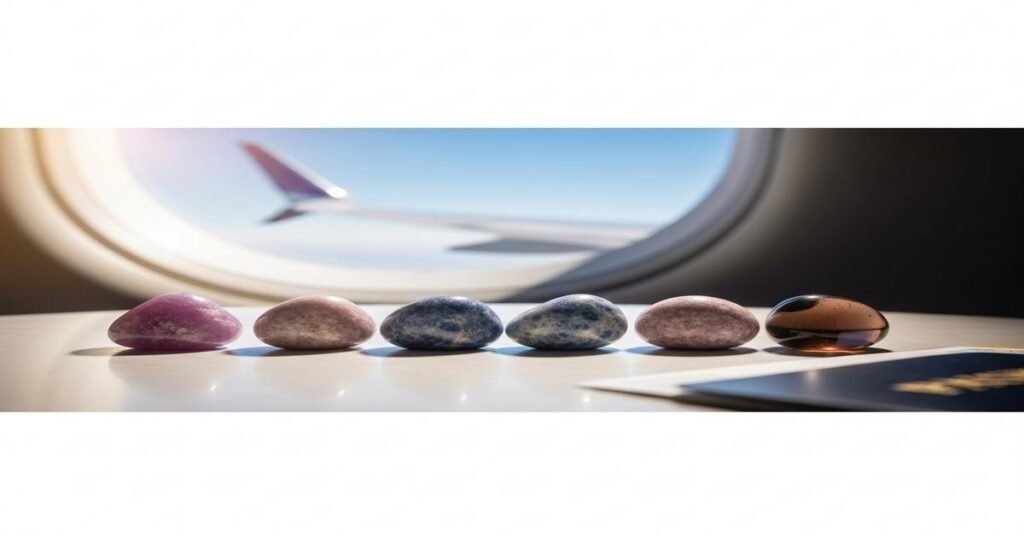Small stones can be useful comfort objects on a flight. They take up little space, don’t attract attention, and most are allowed in carry-on bags. This guide explains which calming stones work best for travel, why certain cuts and metals are smarter choices, and how to carry and care for them so they survive security checks and crowded overhead bins.
Why size, hardness and setting matter. Airports add vibration, jostling and occasional rough handling. Choose stones that can withstand knocks. Hardness (Mohs scale) tells you whether a stone will scratch or chip. Quartz family stones (Mohs ~7) like amethyst and rose quartz are robust. Soft minerals such as selenite (Mohs ~2) or calcite (Mohs ~3) will break or powder. Settings also protect stones: a bezel setting guards edges better than a thin prong. For travel, a small, well-set cabochon or a string of polished beads is both practical and discreet.
Recommended airport-friendly calming stones (with specifics).
- Amethyst (quartz, SiO2) — calming, clarity for anxious thoughts. Hardness: 7. Typical travel size: 6–10 mm cabochon or a 10–20 mm tumble. Example: a 8 mm round cut amethyst usually weighs about 2 ct (0.4 g) depending on cut and density. Why it works: it’s durable, small pieces fit as a pendant or bead, and the color is low-profile.
- Rose quartz (quartz, SiO2) — emotional comfort and soft focus. Hardness: 7. Travel size: 8–15 mm tumble or 6–10 mm cabochon. Choose polished pieces to avoid micro-fractures that shed powder. Why it works: solid feel, pleasant matte finish that doesn’t draw attention.
- Blue lace agate (chalcedony) — soothing for nervous energy and speech. Hardness: 6.5–7. Travel size: 6–12 mm beads or a 10 mm cabochon. Why it works: banded patterns distract the eye and the stone is durable enough for repeated handling.
- Smoky quartz (quartz, SiO2) — grounding and reduces excess adrenaline. Hardness: 7. Travel size: 6–10 mm faceted or cabochon pieces. Why it works: darker tones conceal small scratches and it pairs well with neutral metal settings.
- Amazonite — steadying and helps with motion-related anxiety. Hardness: 6–6.5. Travel size: 6–8 mm beads or a 10 mm tumble. Why it works: soft blue-green color is calming; pick polished beads to avoid flaking.
Stones to avoid for flights. Avoid soft or friable minerals that break to powder (selenite, calcite, some opals). Avoid raw clusters like druzy specimens; they can shed mica-like flakes that look like debris in baggage. Also avoid large specimens with loose crystals — they take space and invite damage.
Metal choices and construction. For settings, prefer low-profile, solid options that won’t snag or flatten in a pocket. Good choices:
- Sterling silver (925 sterling): 92.5% Ag + 7.5% copper or other alloys. Durable and repairable. Pack with an anti-tarnish strip if you travel often.
- 14k gold or 14k gold-filled: 14k gold is about 58.3% gold; gold-filled has a thick layer of real gold mechanically bonded over a base metal. Both resist tarnish better than plated pieces and are less likely to cause skin reactions.
- Low-profile bezels or closed-back settings: They protect edges and keep stones from snagging on fabric or being pressed through a mesh pouch.
Design ideas that travel well. Small pendant (6–10 mm cabochon) on a thin 1 mm chain. Stretch bracelet with 4–6 mm beads so you can touch it without taking it off. Tiny charm on a key chain tucked into a carry-on pouch. Keep the stone as a wearable or in a soft pouch within reach.
Security and packing tips. Pack talismans in your carry-on, not checked baggage. Place them in a soft pouch or small hard case inside an easily accessible pocket. If a piece contains metal, be prepared for it to show on a scanner; removing it at the checkpoint is normal. Avoid loose powdered minerals; powders can attract extra screening. Keep receipts or a small card that lists the stone and metal (e.g., “Amethyst cabochon, 8 mm; sterling silver bezel”) — this helps during a random inspection and reduces back-and-forth with agents.
Care while traveling. Store stones separately so they don’t rub and scratch each other. Use soft cotton or a tiny drawstring pouch. Add a small silica gel packet if you expect humidity; metal will tarnish faster in moist conditions. Clean with a soft cloth. For deeper cleaning use mild soap and water on quartz-family stones; avoid ultrasonic cleaners for stones with fractures or certain treatments.
Matching stone to the flight worry — practical pairings.
- Fear of flying/heightened anxiety: Amethyst or smoky quartz in a small pendant. Breath-focused touch — hold the stone while inhaling for 4 counts and exhaling for 6 counts.
- Motion sickness/unease in movement: Amazonite or blue lace agate beads on a bracelet so you can press them gently against your palm.
- Need to sleep on short flights: Rose quartz tucked against your collarbone or under a scarf provides a tactile anchor and a soft weight to rest on.
Quick checklist before you travel:
- Choose polished pieces or solid cabochons (hardness ≥6) to avoid breakage.
- Prefer bezel over thin prongs for protection.
- Use sterling silver or 14k gold-filled for durability and low maintenance.
- Carry talismans in your carry-on in a soft pouch or small hard case.
- Avoid loose powders, raw clusters, and soft minerals that can flake.
- Have a small ID card describing the piece if questioned at security.
Small travel talismans are about comfort and practicality. Pick durable stones, simple secure settings, and a discreet way to carry them. That way your object of calm survives the trip and does its job without creating hassle at the airport.
I am G S Sachin, a gemologist with a Diploma in Polished Diamond Grading from KGK Academy, Jaipur. I love writing about jewelry, gems, and diamonds, and I share simple, honest reviews and easy buying tips on JewellersReviews.com to help you choose pieces you’ll love with confidence.

